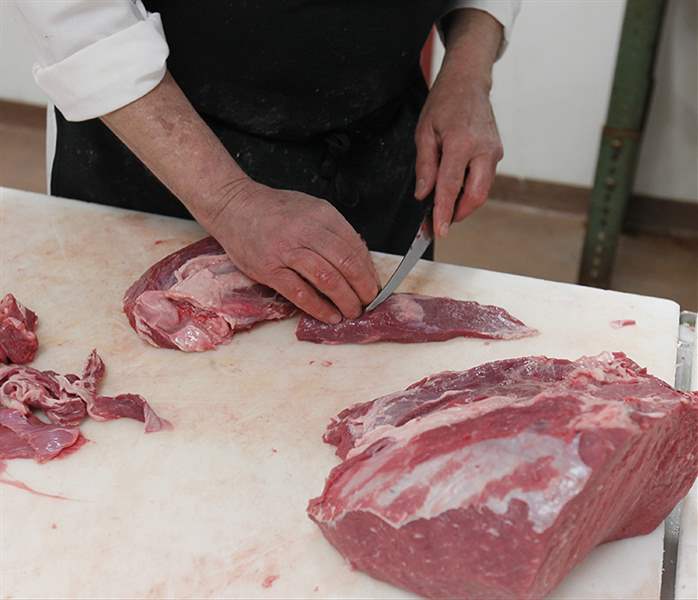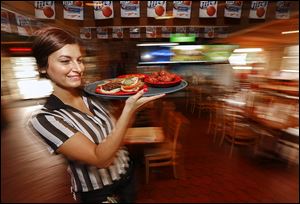
Rising food prices make tabs higher at markets, restaurants
Local merchants, consumers squeezed as meat costs soar
4/27/2014
Mike Driscoll of Walt Churchill’s cleans ups beef knuckle in preparation for making it into stew meat and tip — or breakfast — steaks. Owners of local grocery store chains say they’re trying to hold prices down but can only do so much.
THE BLADE/JETTA FRASER
Buy This Image

One day last week, local grocery store owner Walt Churchill and his wife met some friends for dinner at a local restaurant.
When the check arrived, the owner of Walt Churchill’s Markets in Perrysburg and Maumee was startled.
“I looked at the bill and thought, ‘That much for dinner? Are you kidding me?’ ” Mr. Churchill said. “We could have eaten five meals at home for what we paid. ... I may have to pull back from eating at restaurants.”
But eating more meals at home is also getting more expensive.
The problem, which Mr. Churchill knows too well, is that food prices — at both restaurants and the grocery store — are rising significantly. Caught in the squeeze are consumers, retailers, and wholesale suppliers who are being forced to make some hard decisions as prices climb.
Through March, the price of food is up 1.7 percent during the last year, according to the latest data from the U.S. Labor Department’s Bureau of Labor Statistics. That is running ahead of the general inflation rate, currently at 1.5 percent.
In March alone, retail food prices rose 0.4 percent from February. And in February prices were up 0.4 percent from January, according to bureau data.
Where consumers and retailers are getting gut-punched the hardest is in the animal-protein category, which includes meats such as beef, pork, and poultry, eggs, and seafood.

Mike Driscoll of Walt Churchill’s cleans ups beef knuckle in preparation for making it into stew meat and tip — or breakfast — steaks. Owners of local grocery store chains say they’re trying to hold prices down but can only do so much.
As of March, prices for beef products are up 7.4 percent compared to last year. Pork is up 5.3 percent, poultry is up 3.6 percent, eggs are up 9.9 percent, and seafood is up 5.9 percent.
“I don’t see how a lot of people can afford this. I know they’re changing their eating habits; they have to be, because their incomes just can’t sustain it,” said Mark Wallace, who is the director of operations for northwest Ohio’s eight Ralphie’s Sports and Drink Eatery restaurants.
In the last six weeks, Mr. Wallace said his suppliers have raised the price of boneless, skinless chicken breasts by 40 percent. They have told him to expect prices to rise an additional 15 percent later this week, he said.
Richard Volpe, a food economist with the U.S. Department of Agriculture, says inflation is mostly hitting the products found on the perimeter of a supermarket — meat, eggs, milk — more than the products found in the middle.
“Fruits and vegetables have risen slightly, and you have deflation for all of our condiments, sauces, spreads, side dishes, sugars, sweets, and snacks,” Mr. Volpe said.
Chris Hurt, an agricultural economist at Purdue University, said a variety of factors — some expected, others unforeseen — have combined to push prices up 5.1 percent in the animal-protein category.
The chief culprit is the rising price of beef, the prime source of protein in the United States.
“Beef has gone up and it is going up still,” said Gus Mancy, operator of Mancy’s Steak House in Toledo and a partner in the Mancy Restaurant Group.
“We’re fortunate in that we were able to buy in contracts,” Mr. Mancy said. “We were able to lock our price in for a year at a time so we were set before these price increases. But we’re still not immune from these rising prices. Some other cuts, we can’t lock in. Like tenderloin, because its price fluctuates so much.”
The root of today’s skyrocketing beef prices began in 2007 when cattle producers faced soaring feed prices and shrinking profits.
As a result, some thinned their beef cattle herds just as the southern central plains — prime cattle-herding regions — went into a five-year drought, Mr. Hurt said.
As a result, the nation’s beef-cow herd is at its lowest number since 1962, and the combined beef and dairy-cow herd is at its lowest number since 1951.
Despite the average cow being much larger now — close to 1,300 pounds as compared with 700 pounds 60 years ago — cattle production has dwindled enough to create a demand dilemma.
“If we go back to 2007, we had 65 pounds of beef per person produced. It’s down to 54 pounds available per person this year. That’s 17 percent less beef available per person,” Mr. Hurt said.
But, he added, “We knew that was going to happen.”
What wasn’t anticipated was the growing demand for American beef by foreign nations.
“In the last three to four years there’s enough foreign income wanting our beef that they’re simply outbidding us for it. This is something we haven’t seen before,” Mr. Hurt said. “I don’t remember in my 34 years of watching these meats that we’ve seen this kind of situation. And when I say foreign incomes, I mean China. They’re really making an impact on the food complex across the world.”
Retail beef prices that averaged $5.29 per pound last year are now up to $5.63 per pound, Mr. Hurt said.
Ordinarily, that would force a shift to other meats, such as chicken, ham, or fish.
“Suddenly,” said Mr. Volpe, the USDA economist, “ground turkey becomes an attractive alternative to hamburger. Boneless, skinless chicken breasts are desired as opposed to steak, fish as opposed to chicken, and so on.”
But when beef demand shifts so quickly, “demand spillover drives up prices for pork, poultry, and fish,” Mr. Volpe said.
Pig virus
Mr. Hurt, the Purdue economist, said no one anticipated the porcine epidemic diarrhea virus, a disease that has ravaged the baby pig population in the United States.
“This has trimmed 4 to 5 percent of supplies. That’s 4 to 5 percent that won’t make it to the food supply,” Mr. Hurt said.
“What that says is we were already going to be short on one of the meat components, the beef, and now on pork, that loss wasn’t anticipated and it tightens supplies overall,” Mr. Hurt added.
Egg production is nearly 2 percent higher, but demand for eggs — a less expensive product compared to other meat-protein sources — is higher, causing prices to rise 10 percent.
“Eggs, while 10 percent higher, are really a very high-value nutrition source. There’s considerably more medical information now that eggs are good for you,” Mr. Hurt said.
“So if you’re looking for a substitution, and steak is $12 a pound, here’s a dozen eggs. So what if they’re $4 a dozen,” he said.
When beef prices rise, consumers lament. When beef, pork, poultry, and seafood prices all rise, they howl.
Kroger Co. spokesman Jackie Siekmann said the retailer “is very aware” of rising prices and has been getting an earful from its customers, although there is little the supermarket chain can do.
On April 2, the retailer tried to ease consumer pain by lowering prices on 2,000 of the most commonly purchased items in its stores, a move it linked to ending its policy of doubling manufacturers’ coupons.
But there’s only so much the chain can do to combat a national problem, Ms. Siekmann said.
“We have lowered prices on certain cuts of meats, like our Tri Tip steak, and offered tips on how to prepare them to make them more delicious,” Ms. Siekmann said. “It may not be a ribeye, but it’s still a very good cut of meat.”
Kroger also has tried to cut more deals with its vendors.
“If there’s an overabundance of a cut, we will take so many of these and sell them at below costs. So we’re trying to cut any costs we can,” Ms. Siekmann said.
Making changes
At Walt Churchill’s Markets, Mr. Churchill said the company just changed wholesalers.
“We’re now buying from a retailer-owned co-op and we’re now able to get better prices,” Mr. Churchill said.
“It means we’ve been able to lower some prices. But other items are going up because they’re are going up for us as well. But we’re always looking at ways to hold costs down,” Mr. Churchill said.
“When costs go up, prices are going to go up with them,” he added. “You have margins in the grocery business, and I don’t care who you’re talking about, you have to maintain a margin to stay in business.”

Adriana Scavio carries a tray to customers at Ralphie’s in Perrysburg. Rising food prices present a dilemma to grocers as well to restaurateurs and their wholesalers.
At Ralphie’s, where the menu is heavily geared toward beef and chicken items, Mr. Wallace said his suppliers are trying to get him to buy more frozen items to hold prices down, but he is reluctant to do so.
“They cut you deals on frozen items, but I prefer to stick with fresh,” Mr. Wallace said. “That means you work tight with your vendors and get pricing forecasts a week or two out and deal with that the best you can.”
For now, Ralphie’s plans to hold the line on price increases, believing that what it will lose on its profit margins now can be made up later in the year if — as Mr. Wallace hopes — beef and chicken prices subside.
“That’s the game with food. There’s rises and drops throughout the year. At certain times you take a hard hit on your margins and later on, you hope to make it up,” he said.
But a menu increase hasn’t been completely ruled out, Mr. Wallace added.
“That point hasn’t come yet, but absolutely you have to take that into consideration. We’re not a nonprofit operation,” he said.
No good options
Likewise, Barry Greenblatt, owner of six Barry Bagels restaurants, is taking a wait-and-see approach.
“I don’t want to raise prices now and then have to raise them again in three months,” Mr. Greenblatt said.
“There’s a beef shortage. We know that. Our suppliers have raised costs 20 to 25 percent so far and they said, ‘We don’t see it slowing down,’ ” he said.
If costs keep rising, Mr. Greenblatt said restaurant operators only can deal with that in three ways: smaller portions, lesser quality, or higher menu prices.
“Some restaurants will lower portions. We don’t like doing that. And I can’t change quality — there’s no quicker way to lose your reputation,” he said.
“Which means if it stays up, nobody can absorb that without raising prices,” Mr. Greenblatt said.
The good news currently is that grain cereal and baking products rose only 0.4 in March, while fruits and vegetables rose just 0.6 percent.
But even those two categories may have some ominous clouds building.
California, which produces much of the country’s fruits and vegetables, is in the midst of a severe drought.
“It looks like 7 to 10 percent of the acreage there could get no water this summer,” Mr. Hurt said. “That’s one we’ve got our eye on.”
Meanwhile, grain is susceptible to fickle Midwest weather. “If it’s severe, grain prices could go up quickly. That increase will show up in cereals and baking products,” he said.
Contact Jon Chavez at: jchavez@theblade.com or 419-724-6128.